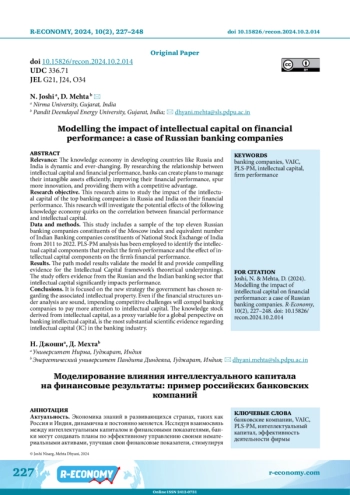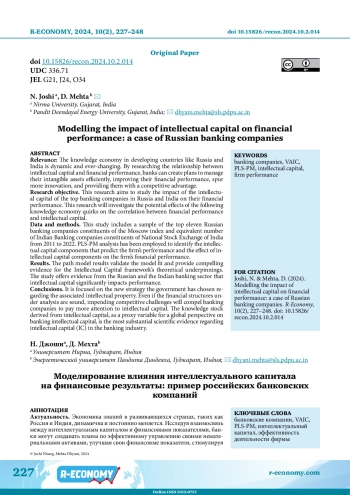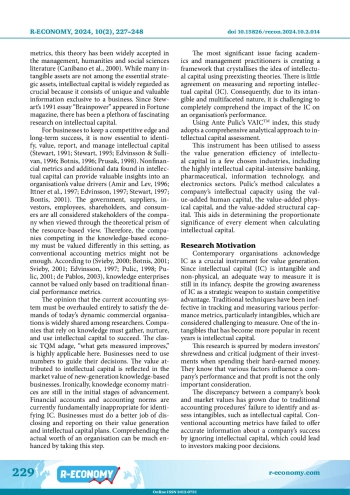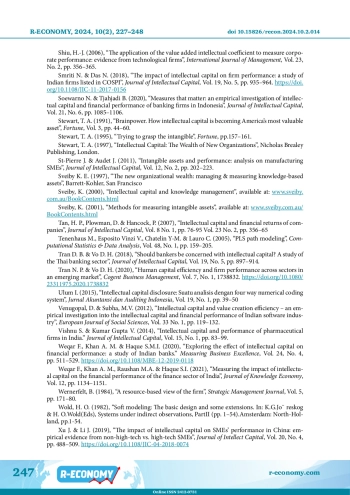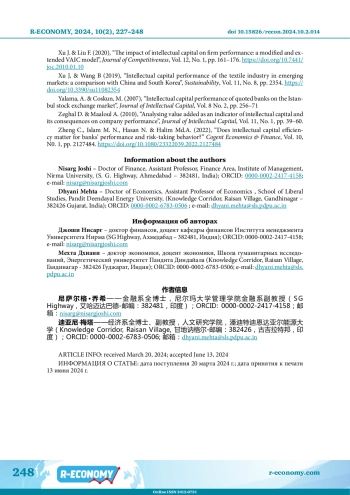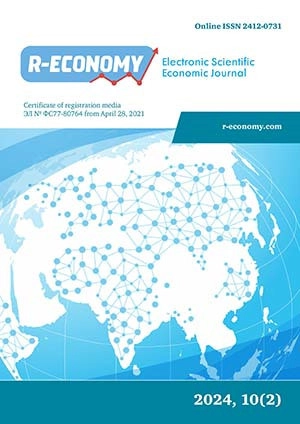Relevance: The knowledge economy in developing countries like Russia and India is dynamic and ever-changing. By researching the relationship between intellectual capital and financial performance, banks can create plans to manage their intangible assets efficiently, improving their financial performance, spur more innovation, and providing them with a competitive advantage. Research objective. This research aims to study the impact of the intellectual capital of the top banking companies in Russia and India on their financial performance. This research will investigate the potential effects of the following knowledge economy quirks on the correlation between financial performance and intellectual capital. Data and methods. This study includes a sample of the top eleven Russian banking companies constituents of the Moscow index and equivalent number of Indian Banking companies constituents of National Stock Exchange of India from 2011 to 2022. PLS-PM analysis has been employed to identify the intellectual capital components that predict the firm’s performance and the effect of intellectual capital components on the firm’s financial performance. Results. The path model results validate the model fit and provide compelling evidence for the Intellectual Capital framework’s theoretical underpinnings. The study offers evidence from the Russian and the Indian banking sector that intellectual capital significantly impacts performance. Conclusions. It is focused on the new strategy the government has chosen regarding the associated intellectual property. Even if the financial structures under analysis are sound, impending competitive challenges will compel banking companies to pay more attention to intellectual capital. The knowledge stock derived from intellectual capital, as a proxy variable for a global perspective on banking intellectual capital, is the most substantial scientific evidence regarding intellectual capital (IC) in the banking industry.
Идентификаторы и классификаторы
Businesses see themselves as continuously developing organisations, and they know that knowledge and information assets spur innovation and are essential to boosting profitability. Both physical as well as intangible assets have the potential to be tactical and significant, according to Wernerfelt (1984) and Rumelt (1984), the creators of the resource-based view. Due to its ability to positively correlate business resources with performance metrics, this theory has been widely accepted in the management, humanities and social sciences literature (Canibano et al., 2000). While many intangible assets are not among the essential strategic assets, intellectual capital is widely regarded as crucial because it consists of unique and valuable information exclusive to a business. Since Stewart’s 1991 essay “Brainpower” appeared in Fortune magazine, there has been a plethora of fascinating research on intellectual capital.
Список литературы
1. Alhassan A. L., Asare N. (2016), “Intellectual capital and bank productivity in emerging markets: evidence from Ghana”, Managment Decision, Vol. 54, No. 3, pp. 589-609.
2. Alipour M. (2012), “The effect of intellectual capital on firm performance: an investigation of Iran insurance companies”, Measuring Business Excellence, Vo. 16, No. 1, pp. 53-66.
3. Al-Musali M. A. K., Ismail K. N. I. K. (2014), “Intellectual capital and its effect on financial performance of banks: evidence from Saudi Arabia”, Procedia - Social and Behavioral Sciences, Vol. 164, pp. 201-207. DOI: 10.1016/j.sbspro.2014.11.068
4. Amir E., Lev B. (1996), “Value-relevance of non-financial information: the wireless communications industry”, Journal of Accounting and Economics, pp. 3-30.
5. Andriessen D. G., Stem C. D. (2004), Intellectual Capital of the European Union: Measuring the Lisbon Agenda Version 2004, Center for Research in Intellectual Capital, IN Holland University of Professional Education, Alkmaar.
6. Anifowose M., Abdul Rashid H. M., Annuar H. A., Ibrahim H. (2018), “Intellectual capital efficiency and corporate book value: evidence from Nigerian economy”, Journal of Intellectual Capital, Vol. 19, No. 3, pp. 644-668. DOI: 10.1108/JIC-09-2016-0091
7. Annie B. (1996), “Intellectual capital, Core asset for the third Millennium enterprise”, International Thompson Business Press, Vol. 1, pp 19-33.
8. Asare N., Laryea M. M., Onumah J. M., Asamoah M. E. (2021), “Intellectual capital and asset quality in an emerging banking market”, Asian Journal Accounting Responsibility, Vol. 6, No. 1, pp. 55-68. DOI: 10.1108/AJAR-05-2020-0034 EDN: XYWBHJ
9. Asiaei K., Jusoh R. (2015), “A multidimensional view of intellectual capital: the impact on organizational performance”, Management Decision, Vol. 53 No. 3, pp. 668-697.
10. Barak M., Sharma R. K. (2023), “Investigating the impact of intellectual capital on the sustainable financial performance of private sector banks in India”, Sustainability, Vol 15, No. 2, pp. 1451. DOI: 10.3390/su15021451 EDN: PBTTDX
11. Barak M., Sharma R. K. (2024), “Does intellectual capital impact the financial performance of Indian public sector banks? An empirical analysis using GMM”, Humanities and Social Sciences Communications, Vol. 11, No. 208. DOI: 10.1057/s41599-024-02702-5 EDN: ANJZDG
12. Bayraktaroglu A. E., Calisir F., Baskak M. (2019), “Intellectual capital and firm performance: an extended VAIC model”, Journal of Intellectual Capital, Vol. 20, No. 3, pp. 406-425. DOI: 10.1108/JIC-12-2017-0184 EDN: PLSPBE
13. Bontis N. (2001), “Assessing knowledge assets: a review of the models used to measure Intellectual capital”, International Journal of Management Reviews, Vol. 3 No. 1, pp. 41-60.
14. Bontis N., Keow C. C., W., Richardson S. (2000), “Intellectual capital and business performance in Malaysian industries”, Journal of Intellectual Capital, Vol. 1, No. 1, pp. 85-100. EDN: EBLAHT
15. Botnis N. (1996), “There is a price on your head: managing intellectual capital strategically”, Business Quarterly.
16. Botnis N. (1999a), “Managing organizational learning system by aligning socks and flows of Knowledge: an empirical examination of intellectual capital, Knowledge and business performance”, PhD thesis, Ivey School of Business, University of Western Ontario, London.
17. Cabrilo S., Dahms, S. (2018), “How strategic knowledge management drives intellectual capital to superior innovation and market performance”, Journal of Knowledge Management, Vol. 22 No. 3, pp. 621-648. EDN: YIFMWT
18. Cabrita M., Vaz J. (2006), “Intellectual capital and value creation: evidence from the Portuguese banking industry”, The Electronic Journal of Knowledge Management, Vol. 4 No. 1, pp. 11-20.
19. Canibano, L., Garcia-Ayuso M., Sanchez P. (2000), “Accounting for intangibles: a literature review”, Journal of Accounting Literature, Vol. 19, pp. 102-30.
20. Cassel C. M., Hack l. P., Westlund A.,H.(2000), “On measurement of intangible assets: A study of robustness of partial least squares”, Total Quality Management, Vol. 11, No. 7, pp. 897-907. EDN: DSVUAF
21. Chan K. H. (2009a), “Impact of intellectual capital on organizational performance: an empirical study of companies in the Hang Seng Index (Part 1)”, The Learning Organization, Vol. 16 No. 1, pp. 4-21.
22. Chan K. H. (2009b), “Impact of intellectual capital on organizational performance: an empirical study of companies in the Hang Seng Index (Part 2)”, The Learning Organization, Vol. 16 No. 1, pp. 22-39.
23. Chang S. L. (2007), “Valuing intellectual capital and firms’ performance - modifying valued added intellectual coefficient (VAICe) in Taiwan IT industry”, dissertation, Golden Gate University, San Francisco, CA.
24. Chen M. C., Cheng S. J., Hwang Y. (2005), “An empirical investigation of the relationship between intellectual capital and firms’ market value and financial performance”, Journal of Intellectual Capital, Vol. 6 No. 2, pp. 159-76.
25. Chin W. W. (1998), “The partial least squares approach to structural equation modelling”, Modern Methods for Business Research, pp. 295-358.
26. Chowdhury L. A. M., Rana T., Akter M., Hoque M. (2018), “Impact of intellectual capital on financial performance: evidence from the Bangladeshi textile sector”, Journal of Accounting & Organizational Change, Vol. 14, No. 4, pp. 429-454.
27. Chu S. K. W., Chan K. H., Yu K. Y., Ng H. T., Wong W. K. (2011), “An empirical study of the impact of intellectual capital on business performance”, Journal of Information & Knowledge Management, Vol. 10, No. 01, pp. 11-21. DOI: 10.1142/S0219649211002791
28. Cohen S., Naoum V. C., Vlismas O. (2014), “Intellectual capital, strategy and financial crisis from a SMEs perspective”, Journal of Intellectual Capital, Vol. 15, No. 2, pp. 294-315. EDN: SONJFZ
29. Cohen J. (1988), “Statistical power analysis for the behavioral sciences” (2nd ed.). Hills dale, NJ: Lawrence Erlbaum Associates.
30. De Pablos P. (2003), “Intellectual capital reporting in Spain: a comparative view”, Journal of Intellectual Capital, Vol. 4 No. 1, pp. 61-81. EDN: EASVJP
31. Diamantopoulos A., Winklhofer H. (2001), “Index construction with formative indicators: An alternative to scale development. Journal of Marketing Research, Vol. 38, No. 2, pp. 269-277. EDN: DNIAYL
32. Drucker P. F. (1993), Post-Capitalist Society, HarperCollins, New York, NY.
33. Dzenopoljac V., Yaacoub C., Elkanj N., Bontis N. (2017), “Impact of intellectual capital on corporate performance: evidence from the Arab region”, Journal of Intellectual Capital, Vol. 18, No. 4, pp. 884-903. EDN: YHDRHS
34. Edvinsson L., Malone M. (1997), “Intellectual capital”. Harper Business, New York, NY.
35. Edvinsson L. (1997), “Developing intellectual capital at Skandia”, Long Range Planning, Vol. 30 No. 3, pp. 266-373. EDN: AHLYSJ
36. Edvinsson L., Sullivan P. (1996), “Developing a model for managing intellectual capital”, European Management Journal, Vol. 14, No. 4. EDN: AMZODP
37. Esposito Vinzi V., Ringle C. M., Squillacciotti S., Trinchera L. (2007), “Capturing and treating unobserved heterogeneity by response based segmentation in PLS path modelling: A comparison of alternative methods by computational experiments. ESSEC Research Center Working Paper 07019, ESSEC Business School Paris-Singapore, Paris.
38. Farooque O. A., AlObaid R. O. H., Khan A. A. (2023), “Does intellectual capital in Islamic banks outperform conventional banks? Evidence from GCC countries”, Asian Review of Accounting,. DOI: 10.1108/ARA-12-2022-0298
39. Firer S., Williams S. M. (2003), “Intellectual capital and traditional measures of corporate performance”, Journal of Intellectual Capital, Vol. 4 No. 3, pp. 348-60. EDN: EASVPT
40. Gan K., Saleh Z. (2008), “Intellectual capital and corporate performance of technology-intensive companies: Malaysia evidence”, Asian Journal of Business and Accounting, Vol. 1 No. 1, pp. 113-130.
41. Ghosh S., Mondal A. (2009), “Indian software and pharmaceutical sector IC and financial performance”, Journal of Intellectual Capital, Vol. 10 No. 3, pp. 369-388.
42. Goh P. C. (2005), “Intellectual capital performance of commercial banks in Malaysia”, Journal of Intellectual Capital, Vol. 6 No. 3, pp. 385-396.
43. Gupta K., Raman T (2021), “The nexus of intellectual capital and operational efficiency: the case of Indian financial system”, Journal of Business Economics, Vol. 91, No. 3, pp. 283-302. EDN: ZVFOLK
44. Hamdan A. (2018), “Intellectual capital and firm performance: differentiating between accounting-based and market-based performance”, International Journal of Islamic and Middle Eastern Finance and Management, Vol. 11, No. 1, pp. 139-151. EDN: YFRJHF
45. Inkinen H. (2015), “Review of empirical research on intellectual capital and firm performance”, Journal of Intellectual Capital, Vol. 16, No. 3, pp. 518-565. DOI: 10.1108/JIC-01-2015-0002 EDN: UOMFDP
46. Innayah M. N., Pratama B. C., Hanafi M. M. (2020), “The effect of intellectual capital towards firm performance and risk with board diversity as a moderating variable: study in ASEAN banking firms”, JDMP (Jurnal Dinamika Manajemen Pendidikan), Vol. 11, No. 1, pp. 27-38.
47. Ittner C. D., Larcker D. F., Rajan M. V. (1997), “The choice of performance measures in annual bonus contracts”, The Accounting Review, April, pp. 231-55.
48. Joshi N., Desai J. (2019). “Financial Restructuring and its Impact on Operating Performance in the Energy Sector in India”, Indian Journal of Finance, Vol. 13, No. 1, pp. 37-54.
49. Joshi N. (2021). “Financial Restructuring and its Impact on Shareholders’ Wealth in Selected Companies in India”, Indian Journal of Finance, Vol. 16, No. 9, pp. 26-41.
50. Kamath G. B. (2007), “The intellectual capital performance of the Indian banking sector”, Journal of Intellectual Capital, Vol. 8, No. 1, pp. 96-123. DOI: 10.1108/14691930710715088
51. Kamath G. B. (2008), “Intellectual capital and corporate performance in Indian pharmaceutical industry”, Journal of Intellectual Capital, Vol. 9 No. 4, pp. 684-704.
52. Kamath G. B. (2015), “Impact of intellectual capital on financial performance and market valuation of firms in India”, International Letters of Social and Humanistic Sciences, Vol. 48 No. 2015, pp. 107-122.
53. Kamukama N., Ahiauzu A., Ntayi J. M. (2010), “Intellectual capital and performance: testing interaction effects”, Journal of Intellectual Capital, Vol. 11 No. 4, pp. 554-574. EDN: OMZOVX
54. Kaplan R. S., Norton D. P. (1996), “The balanced scorecard: translating strategy into action”, Language, Vol. 11, pp. 322.
55. Kapoor S., Saihjpal A. (2022), “Intellectual capital and performance of Indian companies: an empirical investigation”, International Journal of Learning and Intellectual Capital, Vol. 19, No. 6, pp. 608. DOI: 10.1504/IJLIC.2022.126306 EDN: VYIUKC
56. Kasoga P. S. (2020), “Does investing in intellectual capital improve financial performance? Panel evidence from firms listed in Tanzania DSE”, Cogent Economics & Finance, Vol. 8, No.1, 1802815. DOI: 10.1080/23322039.2020.1802815 EDN: PFCREG
57. Khalique M., Ramayah T., Tahir Ali Shah M., Iqbal Z (2019), “Intellectual capital and financial performance of banks in Sialkot Pakistan”, Journal of Management and Science, Vol. 6, No. 1, pp. 50-61. DOI: 10.20547/jms.2014.1906104
58. Khalique M., Bontis N., Abdul Nassir bin Shaari J., HassanIsa M. A. (2015), “Intellectual capital in small and medium enterprises in Pakistan”, Journal of Intellectual Capital, Vol. 16 No. 1, pp. 224-238. EDN: UQVUNJ
59. Kweh Q. L, Lu W-M, Tone K., Nourani M (2022) Risk-adjusted banks’ resource-utilization and investment efficiencies: does intellectual capital matter? Journal of Intellectual Capital, Vol. 23, No. 3, pp. 687-712. DOI: 10.1108/JIC-03-2020-0106 EDN: DPMGRB
60. Kweh Q. L., Lu W.-M., Wang W.-K. (2014), “Dynamic efficiency: intellectual capital in the Chinese non-life insurance firms”, Journal of Knowledge Management, Vol. 18 No. 5, pp. 937-951.
61. Le T. D., Ho T. N., Nguyen D. T., Ngo T. (2022), “Intellectual capital-bank efficiency nexus: evidence from an emerging market”, Cogent Economics & Finance, Vol. 10, No. 1, 2127485. DOI: 10.1080/23322039.2022.2127485
62. Lev B., Zarowin P. (1999), “The boundaries of financial reporting and how to extend them”, Journal of Accounting Research, Vol. 37, No. 2, pp. 353-385.
63. Lev B. (2001), Intangibles: Management, Measurement and Reporting, Brookings Institution Press, Washington, DC.
64. Lev B., Radhakrishnan S. (2003), “The measurement of firm specific organization capital”, NBER Working Paper, No.9581, available at: www.nber.org/papers/w9581.
65. Maditinos D., Chatzoudes D., Tsairidis C., Theriou G. (2011) “The impact of intellectual capital on firms’ market value and financial performance” Journal of Intellectual Capital, Vol. 12 No. 1, 2011 pp. 132-151.
66. Maji S. G., Goswami M. (2017), “Intellectual capital and firm performance in India: a comparative study between original and modified value-added intellectual coefficient model”, International Journal of Learning and Intellectual Capital, Vol. 14, No. 1, pp. 76-89.
67. Mehralian G., Rajabzadeh A., Sadeh M. R., Rasekh H. R. (2012), “Intellectual capital and corporate performance in the Iranian pharmaceutical industry”, Journal of Intellectual Capital, Vol. 13, No. 1, pp. 138-158.
68. Meles A., Porzio C., Sampagnaro G., Verdoliva V. (2016), “The impact of the intellectual capital efficiency on commercial banks performance: evidence from the US”, Journal of Multinational Financial Management, Vol. 36, pp. 64-74.
69. Mention A., Bontis N. (2013), “Intellectual capital and performance within the banking sector of Luxembourg and Belgium”, Journal of Intellectual Capital, Vol. 14, No. 2, pp. 286-309
70. Mohapatra S., Jena S. K., Mitra A., Tiwari A. K. (2019), “Intellectual capital and firm performance: evidence from Indian banking sector”, Applied Economics, Vol. 51, No. 57, pp. 6054-6067. DOI: 10.1080/00036846.2019.1645283
71. Mohiuddin M., Najibullah S., Shahid, A. I. (2006), “An exploratory study on intellectual capital performance of the commercial banks in Bangladesh”, The Cost and Management, Vol. 34 No. 6, pp. 40-54.
72. Mourtisen J., Bukh P. N., Burr B. (2005), “A reporting perspective on intellectual capital”, Perspectives on Intellectual Capital, Vol 1. pp 69-81,. DOI: 10.1016/B978-0-7506-7799-8.50010-3
73. Muhammad N. M. N., Ismail M. K. A. (2009), “Intellectual capital efficiency and firms’performance: study on Malaysian financial sectors”, International Journal of Economics and Finance, Vol. 1 No. 2, pp. 206-1.
74. Nadeem M., Gan C., Nguyen C. (2018), “The importance of intellectual capital for firm performance: evidence from Australia”, Australia Accounting Review, Vol. 28, No. 3, pp. 334-344.
75. Nazari J. A., Herremans I. M. (2007), “Extended VAIC model: measuring intellectual capital components”, Journal of Intellectual Capital, Vol. 8, No. 4, pp. 595-609. DOI: 10.1108/14691930710830774
76. Nimtrakoon S. (2015), “The relationship between intellectual capital, firms’ market value and financial performance: empirical evidence from the ASEAN”, Journal of Intellectual Capital, 16(3): 587-618. DOI: 10.1108/JIC-09-2014-0104
77. Nonaka I. (1995), “The Knowledge Creating Company, Harvard Business Review on Knowledge Management”, Harvard Business School Press, Boston, MA, pp. 21-45.
78. Nuryaman N. (2015), “The influence of intellectual capital on the firm’s value with the financial performance as intervening variable”, Procedia Social and Behavioral Sciences, Vol. 211 No. 2015, pp. 292-298.
79. Ozkan N., Cakan S., Kayacan M. (2017), “Intellectual capital and financial performance: a study of the Turkish banking sector”, Borsa Istanbul Review, Vol. 17, No. 3, pp. 190-198. DOI: 10.1016/j.bir.2016.03.001
80. Pal K., Soriya S. (2012), “IC performance of Indian pharmaceutical and textile industry”, Journal of Intellectual Capital, Vol. 13, No. 1, pp. 120-137. DOI: 10.1108/14691931211196240
81. Phusavat K., Comepa N., Sitko-Lutek A., Ooi K. B. (2011), “Interrelationships between intellectual capital and performance: empirical examination”, Industrial Management & Data Systems, Vol. 111, No. 6, pp. 810-829.
82. Poh L. T., Kilicman A., Ibrahim S. N. I. (2018), “On intellectual capital and financial performances of banks in Malaysia”, Cogent Economics & Finance, Vol. 6, No. 1, 1453574. DOI: 10.1080/23322039.2018.1453574
83. Prusak L. (1998), “Working Knowledge: How organizations Manage What They Know”, Harvard Business School Press, Cambridge, MA.
84. Pulic A. (2004), “Intellectual capital-does it create or destroy value?”, Measuring Business Excellence, Vol. 8, No. 1, pp. 62-68.
85. Pulic A. (1998), “Measuring the performance of intellectual potential in knowledge economy” www.measuringip.at/Opapers/Pulic/Vaictxt.vaictxt.html.
86. Pulic A. (2000a), “VAIC - an accounting tool for IC management”, available at: www.measuringip.at/Papers/ham99txt.htm.
87. Pulic A. (2000b), “MVA and VAIC analysis of randomly selected companies from FTSE 250”, available at: www.vaicon.net/downloads/ftse30.pdf.
88. Pulic A. (2001), “Value creation efficiency analysis of Croatian banks 1996-2000”, available online at www.vaic-on.net.
89. Pulic A. (2004), “Intellectual capital-does it create or destroy value?”, Measuring Business Excellence, Vol. 8 No. 1, pp. 62-8.
90. Puntillo P. (2009), “Intellectual capital and business performance. Evidence from Italian banking industry”, Electronic Journal of Corporate Finance, Vol. 4 No. 12, pp. 97-115. EDN: KZCTET
91. Riahi-Belkaoui A. (2003), “Intellectual capital and firm performance of US multinational firms”, Journal of Intellectual Capital, Vol. 4 No. 2, pp. 215-226. EDN: EASVNB
92. Rowlands J. (2018), “Deepening understandings of Bourdieu’s academic and intellectual capital through a study of academic voice within academic governance”, Studies in Higher Education, Vol. 43, No. 11, pp. 1823-1836.
93. Rumelt R. P. (1984), “Towards a strategic theory of the firm”, in Lamp, R.B. (Ed.), Competitive Strategic Management, Prentice-Hall, Englewood Cliffs, NJ.
94. Samiloglu A. T. (2006), “The performance analysis of the Turkish banks through VAIC and MV/MB ratio”, Journal of Administrative Sciences, Vol. 4 No. 1, pp. 207-226.
95. Sardo F., Serrasqueiro Z. (2017), “A European empirical study of the relationship between firms’ intellectual capital, financial performance and market value”, Journal of Intellectual Capital, Vol. 18, No. 4, pp. 771-788. DOI: 10.1108/JIC-10-2016-0105
96. Shiu H.-J. (2006), “The application of the value added intellectual coefficient to measure corporate performance: evidence from technological firms”, International Journal of Management, Vol. 23, No. 2, pp. 356-365.
97. Smriti N., Das N. (2018), “The impact of intellectual capital on firm performance: a study of Indian firms listed in COSPI”, Journal of Intellectual Capital, Vol. 19, No. 5, pp. 935-964. DOI: 10.1108/JIC-11-2017-0156
98. Soewarno N., Tjahjadi B. (2020), “Measures that matter: an empirical investigation of intellectual capital and financial performance of banking firms in Indonesia”, Journal of Intellectual Capital, Vol. 21, No. 6, pp. 1085-1106. EDN: GCZZEA
99. Stewart T. A. (1991), “Brainpower. How intellectual capital is becoming America’s most valuable asset”, Fortune, Vol. 3, pp. 44-60.
100. Stewart T. A. (1995), “Trying to grasp the intangible”, Fortune, pp.157-161.
101. Stewart T. A. (1997), “Intellectual Capital: The Wealth of New Organizations”, Nicholas Brealey Publishing, London.
102. St-Pierre J, Audet J. (2011), “Intangible assets and performance: analysis on manufacturing SMEs”, Journal of Intellectual Capital, Vol. 12, No. 2, pp. 202-223. EDN: OMZOWR
103. Sveiby K. E. (1997), “The new organizational wealth: managing & measuring knowledge-based assets”, Barrett-Kohler, San Francisco.
104. Sveiby K. (2000), “Intellectual capital and knowledge management”, available at: www.sveiby.com.au/BookContents.html.
105. Sveiby K. (2001), “Methods for measuring intangible assets”, available at: www.sveiby.com.au/BookContents.html.
106. Tan H. P., Plowman D., Hancock P. (2007), “Intellectual capital and financial returns of companies”, Journal of Intellectual Capital, Vol. 8 No. 1, pp. 76-95 Vol. 23 No. 2, pp. 356-65.
107. Tenenhaus M., Esposito Vinzi V., Chatelin Y-M., Lauro C. (2005), “PLS path modeling”, Computational Statistics & Data Analysis, Vol. 48, No. 1, pp. 159-205.
108. Tran D. B., Vo D. H. (2018), “Should bankers be concerned with intellectual capital? A study of the Thai banking sector”, Journal of Intellectual Capital, Vol. 19, No. 5, pp. 897-914.
109. Tran N. P., Vo D. H. (2020), “Human capital efficiency and firm performance across sectors in an emerging market”, Cogent Business Management, Vol. 7, No. 1, 1738832. DOI: 10.1080/23311975.2020.1738832 EDN: TCAQII
110. Ulum I. (2015), “Intellectual capital disclosure: Suatu analisis dengan four way numerical coding system”, Jurnal Akuntansi dan Auditing Indonesia, Vol. 19, No. 1, pp. 39-50.
111. Venugopal D., Subha M. V. (2012), ‘‘Intellectual capital and value creation efficiency - an empirical investigation into the intellectual capital and financial performance of Indian software industry’’, European Journal of Social Sciences, Vol. 33 No. 1, pp. 119-132.
112. Vishnu S., Kumar Gupta V. (2014), “Intellectual capital and performance of pharmaceutical firms in India”. Journal of Intellectual Capital, Vol. 15, No. 1, pp. 83-99.
113. Weqar F., Khan A. M., Haque S. M. I. (2020), “Exploring the effect of intellectual capital on financial performance: a study of Indian banks”. Measuring Business Excellence, Vol. 24, No. 4, pp. 511-529. DOI: 10.1108/MBE-12-2019-0118 EDN: JISHEQ
114. Weqar F., Khan A. M., Raushan M. A., Haque S. I. (2021), “Measuring the impact of intellectual capital on the financial performance of the finance sector of India”, Journal of Knowledge Economy, Vol. 12, pp. 1134-1151.
115. Wernerfelt B. (1984), “A resource-based view of the firm”, Strategic Management Journal, Vol. 5, pp. 171-80.
116. Wold H. O. (1982), “Soft modeling: The basic design and some extensions. In: K.G.Jo¨ reskog & H. O.Wold(Eds), Systems under indirect observations, PartII (pp. 1-54).Amsterdam: North-Holland, pp. 1-54.
117. Xu J., Li J. (2019), “The impact of intellectual capital on SMEs’ performance in China: empirical evidence from non-high-tech vs. high-tech SMEs”, Journal of Intellect Capital, Vol. 20, No. 4, pp. 488-509. DOI: 10.1108/JIC-04-2018-0074 EDN: FHTIQX
118. Xu J., Liu F. (2020), “The impact of intellectual capital on firm performance: a modified and extended VAIC model”, Journal of Competitiveness, Vol. 12, No. 1, pp. 161-176. DOI: 10.7441/joc.2010.01.10 EDN: MPERGF
119. Xu J., Wang B (2019), “Intellectual capital performance of the textile industry in emerging markets: a comparison with China and South Korea”, Sustainability, Vol. 11, No. 8, pp. 2354. DOI: 10.3390/su11082354 EDN: LCKFOZ
120. Yalama A., Coskun M. (2007), “Intellectual capital performance of quoted banks on the Istanbul stock exchange market”, Journal of Intellectual Capital, Vol. 8 No. 2, pp. 256-71.
121. Zeghal D., Maaloul A. (2010), “Analysing value added as an indicator of intellectual capital and its consequences on company performance”, Journal of Intellectual Capital, Vol. 11, No. 1, pp. 39-60.
122. Zheng C., Islam M. N., Hasan N., Halim Md. A. (2022), “Does intellectual capital efficiency matter for banks’ performance and risk-taking behavior?” Cogent Economics & Finance, Vol. 10, N0. 1, pp. 2127484. DOI: 10.1080/23322039.2022.2127484
Выпуск
Другие статьи выпуска
Relevance. The paper explores interregional cooperation, examining the challenges of aligning spatial and innovation development in macro-regions, with a focus on two federal districts of Russia. The study assesses the potential of interregional cooperation among neighboring regions within a single federal district, as well as among more distant regions across different federal districts. Research Objective. The study aims to test two hypotheses: the first deals with the viability of imitation innovation strategies in peripheral regions of both intra and inter-federal districts. The second hypothesis concerns the presence of innovation interdependence (autocorrelation) among regions from different federal districts, influenced by the level and industrial compatibility of innovation outputs. Data and methods. The study employs the DEA method to identify central and peripheral regions (imitator regions) by calculating technical efficiency indicators. It also uses coupling interregional complementarity indexes to assess the potential for interregional cooperation in innovation and technological import substitution, considering the industrial profiles of the regions. Spatial autocorrelation is evaluated by using Moran’s Index to estimate the level of regional interdependence, factoring in the level and industry conformity of innovation output. The novelty of the proposed methodological approach lies in the application of interregional indexes of innovation complementarity as weighting coefficients in Moran’s Index calculation. Results. The study reveals a rise in spatial inequality, competition among regions, and constrained interregional innovation cooperation across federal districts. Geographical proximity currently plays a pivotal role in cooperation, with initial indications of a macro-regional space evolving through knowledge exchange. However, both hypotheses concerning imitation strategies and autocorrelation are only confirmed for regions within a single federal district. Conclusions. The findings of this study regarding spatial autocorrelation offer valuable insights for policymakers in the sphere of regional innovation.
Relevance. As permanent settlements in the Russian Far North suffer increasing depopulation, a “shadow” settlement framework is emerging through rotational labor migration. Despite nearly half a century of history, rotational shift work in the North remains largely spontaneous, posing risks to sustainable development. Research Objective. This study examines rotational shift settlements as elements of the population settlement system in the Russian Far North and analyzes their role in transforming the region’s settlement patterns. Data and Methods. Data on rotational shift camps were gathered from various open web sources and the Ministry for the Development of the Far East and the Arctic. Information on permanent settlements was obtained from Rosstat (Federal State Statistics Service). The study employed systemic and comparative analysis methods. Results. Unlike other Russian regions, rotational shift settlements in the Far North were initially integrated into the local settlement system. However, socio-economic changes in the 1990s disrupted the established Soviet model of integration, leading to the spontaneous development of these settlements. This unregulated growth poses increasing risks in such areas as ecology and social well-being. Conclusions. To regulate the status of rotational settlements, legislative initiatives should be supported by updated conceptual and terminological frameworks. The urbanization process in this geostrategically important and environmentally vulnerable region must be controlled or at least predictable to ensure timely responses to emergencies.
Relevance. Intergovernmental budgetary regulation is pivotal for promoting territorial equalization and bridging socio-economic gaps among regions. It ensures equitable access to public goods for all citizens, irrespective of their location. The effective distribution of federal financial assistance, guided by the principles of budget federalism, is essential for maintaining macroeconomic stability and fostering sustainable socio-economic development on the national and regional levels. Research Objective. The study aims to assess the competitive positions of Russian regions within the distribution system of federal intergovernmental transfers. Method and Data. To investigate Russia’s system of intergovernmental transfers, the research employs statistical methods, including structural-dynamic, grouping, and graphical analysis, along with novel analytical tools like the dependence coefficient and income coefficient. The study encompasses data from 2015 to 2022, sourced from the Federal Treasury and Federal State Statistics Service (Rosstat). Results. The study analyzes the dynamics of transfers from the federal budget to regional budgets and shows significant transformations in the transfer structure, revealing a decrease in non-targeted transfers and an increase in targeted ones. The study also examines the differences between regions in the distribution of these transfers. Russian regions were grouped depending on the share of federal transfers in their total budget income and the average per capita income in their consolidated budget. The study introduces a novel methodological approach through the use of newly developed tools - the dependence coefficient and income coefficient - to evaluate regional competitiveness. Conclusion. Despite an overall increase in federal transfers, persistent regional disparities intensify competition for financial assistance. These findings can be of interest to policymakers at federal and regional levels, researchers, and educators in relevant fields.
Relevance. In the current economic climate, maintaining the integrity of regional economic space is crucial. This involves ensuring uniform socio-economic development across regions and promoting a high rate of technology transfer from the center to the periphery. Therefore, it is essential to identify sustainable points of spatial development that represent centers of power concentration and guide spatial transformation. Research objective. The study aims to assess the connectivity of the region’s economic space by measuring population mobility. This approach will help identify the centers of social and labor communications that represent sustainable points of spatial development. The focus of the study is on the municipal districts of Sverdlovsk region, which are key elements of its economic space. Data and methods. The study employed geoinformation analysis of origin-destination matrix of population flows in Sverdlovsk region (Russian Federation), provided by Russian mobile operators. Results. The paper presents the analysis of intracity and intercity population flows based on the average daily data of mobile operators for 2022. The intensity and diversification of population flows in the region’s municipal districts, reflecting the connectivity of its economic space, were estimated using geographic information systems and the Python programming language. The study revealed that Sverdlovsk region has a bicentric system of spatial interconnections, with two distinct centers of attraction: Ekaterinburg and Nizhny Tagil, with Ekaterinburg being the dominant center. Conclusions. The proposed classification of municipal districts by the level of their inclusion into the economic space of Sverdlovsk region illustrates that only 5% are characterized by intensive and diversified inter-territorial interaction, while 34% are characterized by low indicators of intensity and diversification of mobile population flows. The spatial structure of the municipalities in Sverdlovsk region, which are located in the zone of attraction to the agglomeration centers, will be maintained and reinforced.
Relevance. Fostering well-being ranks high on regional social policy agendas. With the dynamic shifts in the international economic landscape, known as geo-economic fragmentation, there’s a pressing urgency for stakeholders to optimize resource allocation at the regional level, increasing interest in efficient strategies to adapt to sanctions while enhancing overall well-being. Research objective. This article aims to investigate the dimensions and determinants of the eco- and human capital efficiency in Russian regions in the context of geo-economic fragmentation and sanctions pressure. Data and methods. A proposed three-stage approach integrates factor analysis to identify subjective well-being indicators, data envelopment analysis (DEA) to evaluate socio-eco-efficiency, and panel tobit regression to examine the determinants of efficiency. Microdata from the Rossat Comprehensive Observation of Living Conditions database were utilized, covering the period from 2014 to 2022. To assess efficiency, a DEA model is employed. The output indicators from this model were the estimated measures of subjective well-being. These indicators were validated through factor analysis and included professional satisfaction, safety assessment, accessibility and quality of social and cultural infrastructure in the regions. Results. In the given period, people reported feeling increasingly satisfied with jobs and quality of life, though there was a noticeable slowdown in the growth of human capital development indicators, environmental investments, and real income by early 2023. Efficiency varied significantly among the regions. Industrially developed mining areas and republics in the North Caucasus consistently showed high socio-eco-efficiency, despite limited resources. The efficiency benefited both from digitalization and increased per capita gross regional product, but urbanization had a negative impact. Conclusions. Amid geo-economic fragmentation, regional communities and job markets face significant challenges in adaptation. With the looming risk of declining satisfaction and perceived quality of life, it is imperative for regional policies to bolster tangible well-being indicators and invest in social capital and infrastructure to address these issues effectively.
Relevance. Ensuring equal access to resources is crucial for social development, especially in rural areas. Women in these regions face distinct challenges due to traditional lifestyles and cultural norms, impacting their access to education, healthcare, and economic opportunities. Addressing these challenges is vital for the overall development of rural communities. Research objective. This study aims to develop methodological approaches to assessing women’s access to resources in rural areas of Kazakhstan. Data and methods. Based on the investigation of methodological approaches, multinomial logistic regression analysis was proposed to assess the impact of regional differences on gender gaps in access to various resources. The study is based on qualitative data collected from May to June 2023 from a sociological survey conducted among women aged 18-60 in rural settlements of Kazakhstan. A total of 600 respondents were interviewed, and 542 of the respondents had completed questionnaires. This methodology enables the collection, analysis, and processing of primary data, aiding in the assessment of gender disparities in resource access. Results. The proposed methodology facilitated a thorough analysis of qualitative data, offering insights into the problem of gender disparities. Most respondents rated their access to social and economic resources as average, suggesting that while there are available resources, they might not fully meet rural women’s needs or expectations in terms of level or quality. Conclusions. Regions like Akmola, Atyrau, Mangystau, North Kazakhstan, Turkestan, and Zhambyl show significant disparities in resource access, indicating regional inequalities. Addressing this gap necessitates collaborative efforts between government and businesses to enhance resource availability and broaden opportunities for rural women.
Статистика статьи
Статистика просмотров за 2025 год.
Издательство
- Издательство
- УрФУ
- Регион
- Россия, Екатеринбург
- Почтовый адрес
- 620002, Свердловская область, г. Екатеринбург, ул. Мира, д. 19
- Юр. адрес
- 620002, Свердловская область, г. Екатеринбург, ул. Мира, д. 19
- ФИО
- Кокшаров Виктор Анатольевич (Ректор)
- E-mail адрес
- rector@urfu.ru
- Контактный телефон
- +7 (343) 3754507
- Сайт
- https://urfu.ru/ru
